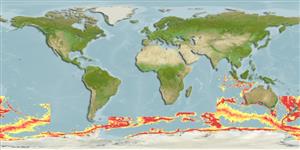Pycnogonida |
Pantopoda |
Colossendeidae
Environment: milieu / climate zone / djupintervall / distribution range
Ekologi
; djupintervall 408 - 3900 m (Ref. 9). Temperate
Indo-West Pacific and Antarctic Pacific: South Sandwich Island, Australia, and New Zealand.
Length at first maturity / Size / Weight / Age
Könsmognad: Lm ? range ? - ? cm
Proboscis very narrow, long and straight. It is nearly twice the trunk diameter and has a very little median swelling. Ocular tubercle a low bump, eyes indistinct. Seventh palp segment very long, slender, eighth segment semi triangular, with ventral tubercle or extension, ninth subequal to eighth, tenth twice as long, both carried recurved dorsally. Oviger terminal segment with enlarged distal denticulate spine forming subchela with moderately long curved terminal claw. Femora the longest major leg segments. Tarsus slightly longer than propodus, claw long, variable, sometimes longer than propodus (Ref. 9).
Continental rise, continental slope, shallow subtidal (Ref. 1456).
Life cycle and mating behavior
Könsmognad | Reproduktion | Lek | Eggs | Fecundity | Larvae
Members of the class Pycnogonida are gonochoric and sexually dimorphic. During copulation, male usually suspends itself beneath the female. Fertilization occurs as the eggs leave the female's ovigers. Males brood the egg masses until they hatch. Life cycle: Eggs hatch into protonymphon larva then to adults.
Child, C.A. 1998 The marine fauna of New Zealand: Pycnogonida (sea spiders). NIWA Biodiversity Memoire 109. National Institute of Water and Atmospheric Research (NIWA). Washington, D.C. 20530, USA. 71 p. + Figure 2A-G, 3A-F, 4, 5. (Ref. 9)
IUCN Red List Status
(Ref. 130435: Version 2025-1)
CITES status (Ref. 108899)
Not Evaluated
Not Evaluated
Threat to humans
Human uses
| FishSource |
Verktyg
Ytterligare information
Trophic EcologyFood items (preys)
Födosammansättning
Födointag
Predatorer
Population dynamicsTillväxt
Max. ages / sizes
Length-weight rel.
Length-length rel.
Length-frequencies
Mass conversion
Abundans
PhysiologySyreförbrukning
Human RelatedStamps, coins, misc.
Internet-källor
Estimates based on models
Preferred temperature
(Ref.
115969): 0.1 - 4.1, mean 2.5 (based on 1264 cells).
Price category
Unknown.
